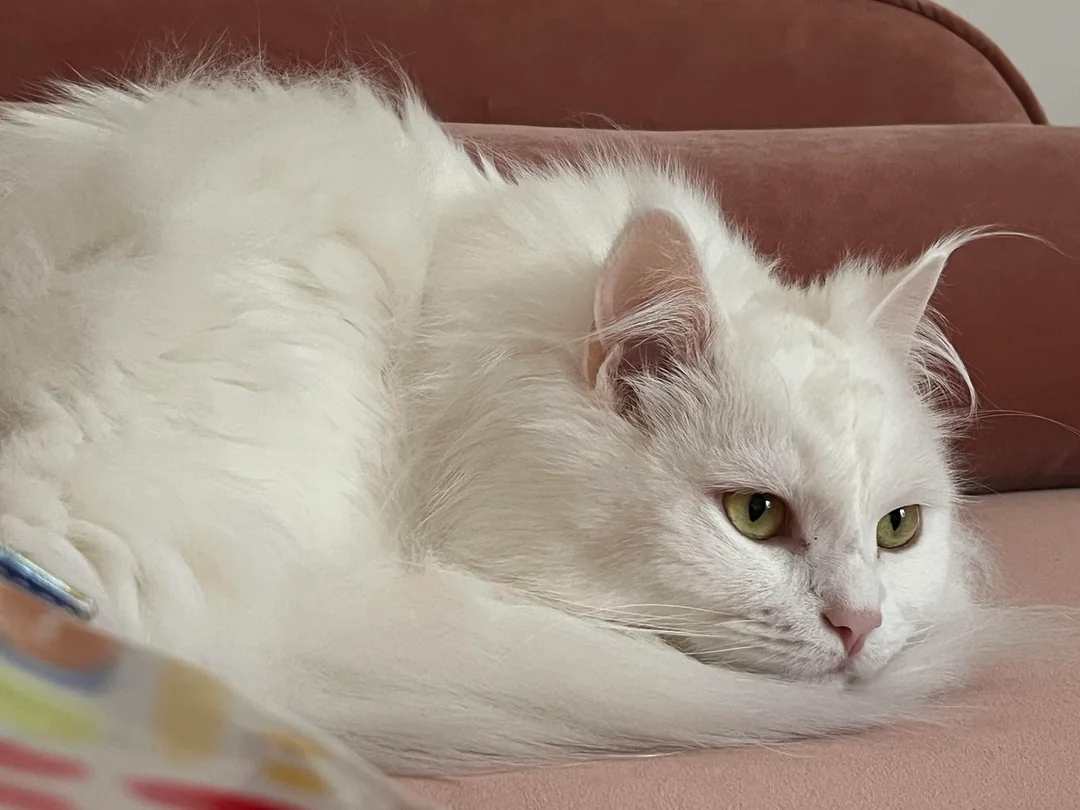Yes, Ragdolls sleep a lot, with a typical daily snooze ranging from 12 to 16 hours a day. These adorable felines love their rest time and can often be found curled up in cozy spots for long periods. Their deep restful sleep cycles are essential for their well-being. If you want to uncover more about Ragdolls’ sleep habits and how to create a sleep-friendly environment for them, keep exploring the factors that influence their slumber, their nap characteristics, and signs of a contented and restful Ragdoll.
Ragdolls’ Sleep Patterns and Routines
Ragdolls exhibit distinctive sleep patterns and routines that are essential to their well-being. Ensuring good sleep quality is vital for these feline companions to thrive. Sleep deprivation can lead to health issues, affecting their overall happiness and behavior.
Maintaining proper sleep hygiene is key in promoting restful sleep for Ragdolls. Factors like providing a comfortable sleeping environment and a consistent bedtime routine can contribute to better sleep quality. It’s also important to be mindful of potential sleep disorders that could disrupt their rest.
Factors Influencing Ragdolls’ Sleep
When considering factors that influence the sleep of Ragdolls, it’s important to examine their daily activity levels and environmental stimuli.
Ragdolls’ sleep quality can be affected by stress, whether from changes in routine or interactions with other pets. Additionally, their environment plays a significant role; disturbances like loud noises or bright lights can disrupt their rest.
Providing a calm and comfortable sleeping space for Ragdolls can help promote better sleep habits. By reducing stressors and minimizing disturbances in their surroundings, owners can contribute to ensuring that Ragdolls get the rest they need to stay healthy and happy.
Typical Daily Sleep Duration
Considering the factors influencing Ragdolls’ sleep, it’s important to understand their typical daily sleep duration. Ragdolls typically sleep for around 12 to 16 hours a day, influenced by factors like sleep quality, nap frequency, resting habits, and nighttime routines.
Their extended daily sleep duration is crucial to maintaining their overall well-being and health. Ragdolls tend to have deep, restful sleep cycles, ensuring they wake up refreshed and energized. Their nap frequency throughout the day contributes to their total sleep hours, with intermittent rest periods aiding in their overall alertness and vitality.
Characteristics of Ragdoll Cat Naps
Throughout the day, Ragdoll cats often engage in short and rejuvenating cat naps that contribute to their overall well-being and alertness. The sleep quality of these cat naps is influenced by the environment in which the cat feels safe and comfortable.
Ragdolls typically have multiple nap sessions during the day, with each nap lasting around 15 to 20 minutes. These frequent but brief naps help Ragdolls recharge their energy levels while still staying aware of their surroundings.
Creating a peaceful and cozy nap spot for your Ragdoll can enhance the quality and duration of their naps, ensuring they get the rest they need to remain active and playful throughout the day.

Signs of a Restful Ragdoll
We can easily spot a restful Ragdoll by observing their sleep patterns, duration, and behaviors. Their distinct sleeping habits, such as curling up in a cozy spot or stretching out in full relaxation, can give us insights into their level of restfulness.
Sleep Patterns
Ragdolls typically exhibit a consistent and peaceful sleep pattern, often curling up in cozy spots for long periods of rest. Maintaining good sleep quality and hygiene is essential for their overall well-being. Ragdolls are less prone to sleep disorders or deprivation due to their natural inclination for deep and restful sleep.
To guarantee your Ragdoll’s sleep patterns remain healthy, consider the following:
- Providing a comfortable and quiet sleeping environment
- Establishing a routine for bedtime and wake-up time
- Monitoring their behavior for any signs of restlessness or sleep disturbances
Sleep Duration
Moving from discussing sleep patterns, understanding the sleep duration of a Ragdoll can provide insights into their overall restfulness and well-being. Ragdolls typically need around 12-16 hours of sleep per day. Adequate sleep duration is essential for their health and happiness.
A restful Ragdoll often displays good sleep quality, with deep, uninterrupted sleep cycles. Sleep disturbances, such as frequent waking or restlessness during the night, can indicate underlying issues that may affect their well-being.
Ensuring proper sleep hygiene, such as a comfortable sleeping environment and a consistent bedtime routine, can help promote a peaceful night’s rest for your Ragdoll. By monitoring their sleep duration and addressing any sleep disturbances promptly, you can help your Ragdoll maintain excellent health and happiness.
Sleeping Behaviors
Observing a content Ragdoll peacefully curled up in a cozy spot is a clear indication of their restful sleeping behavior. Ragdolls exhibit exemplary sleep quality, characterized by long periods of deep, undisturbed rest.
Their serene demeanor while asleep reflects their peaceful state of mind and physical relaxation. When it comes to sleep disturbances, Ragdolls are quite resilient, often adapting well to changes in their environment or routine. They can easily return to their restful state even after minor disruptions.
Overall, the tranquil and content expression on a Ragdoll’s face as they snooze showcases their ability to achieve a truly restful sleep experience.
- Long periods of deep, undisturbed rest
- Serene demeanor while asleep
- Resilience to sleep disturbances

Impact of Age on Sleep Needs
As cats age, their sleep needs may change, requiring adjustments in their daily routines. Aging impacts not only the quantity but also the quality of sleep in Ragdolls. Older cats tend to sleep more lightly and may wake up more frequently during the night. This can lead to increased daytime napping to compensate for the interrupted rest.
Changes in sleep habits are common as Ragdolls grow older, with some seniors becoming more restless while sleeping compared to their younger counterparts. Understanding these shifts is essential for providing the necessary comfort and support to aging Ragdolls. By recognizing the evolving sleep patterns of older cats, we can make sure they receive the rest they need to stay healthy and happy.
Ragdoll Kittens Vs. Adult Cats
When comparing Ragdoll kittens to adult cats, it’s evident that their sleep patterns and behaviors differ greatly. Ragdoll kittens are in their growth stages, which leads to higher activity levels compared to adult cats. They exhibit playful and curious behaviors, constantly exploring their surroundings.
Additionally, changes in behavior are noticeable as Ragdoll kittens progress into adult cats. They tend to become more independent and develop their unique personalities. Feeding habits also evolve from frequent small meals as kittens to fewer but larger meals as adult cats.
Coping With Excessive Sleeping
We’ll explore the importance of analyzing Ragdolls’ sleep patterns and how to establish healthy sleep habits for these cats.
Sleep Patterns Analysis
Let’s explore the analysis of Ragdolls’ sleep patterns, especially in managing excessive sleeping habits.
Ragdolls, like all cats, are known for their love of sleeping. However, excessive sleeping can sometimes indicate underlying issues. When analyzing sleep patterns, factors such as sleep quality, sleep disorders, sleep hygiene, and sleep deprivation play vital roles.
Here are three key points to take into account:
- Monitoring Ragdolls’ sleep duration and frequency can help identify any irregularities.
- Consult a vet if excessive sleeping persists despite changes in the cat’s environment.
- Creating a comfortable and stimulating environment for Ragdolls to promote healthy sleep habits.
Healthy Sleep Habits
To promote healthy sleep habits in Ragdolls and cope with excessive sleeping, creating a consistent daily routine is essential. Establishing good sleep hygiene practices and a calming bedtime routine can help regulate their sleep patterns. Monitoring nap frequency is vital to make sure they are not oversleeping during the day, which may impact their nighttime rest.
Additionally, paying attention to sleep quality is important; factors like noise levels and the comfort of their sleeping area can influence how well they rest. By maintaining a structured routine, Ragdolls can develop healthier sleep habits and reduce the likelihood of excessive sleeping.
| Healthy Sleep Habits | Tips for Ragdolls |
|---|---|
| Sleep hygiene | Establish a calming bedtime routine |
| Bedtime routine | Ensure a quiet and comfortable sleeping area |
| Nap frequency | Monitor and limit daytime naps |
| Sleep quality | Create a peaceful sleep environment |
Creating a Sleep-Friendly Environment
Establishing a cozy and calm atmosphere can help Ragdolls feel more relaxed and encourage better sleep habits.
To create a sleep-friendly environment for your Ragdoll, consider the following:
- Consistent Bedtime Routines: Establishing a regular bedtime routine can signal to your cat that it’s time to wind down and prepare for sleep.
- Comfortable Sleep Accessories: Providing soft bedding and cozy blankets can enhance your Ragdoll’s comfort and help them feel secure while resting.
- Relaxation Techniques: Incorporating soothing activities like gentle petting or playing soft music can help your Ragdoll relax and unwind before bedtime.
Understanding Ragdolls’ Sleep Cycles
Understanding Ragdolls’ sleep cycles is crucial for creating a peaceful sleep environment for them. This knowledge can offer insights into their rest patterns and behaviors, helping improve their sleep quality.
Establishing a consistent bedtime routine for Ragdolls, which includes interactive play sessions to help them unwind before sleep, is vital. Providing a comfortable sleeping area with cozy bedding and a soothing atmosphere can also contribute to promoting better sleep quality.
Frequently Asked Questions
Do Ragdolls Snore When They Sleep?
When we talk about sleep patterns, some cats, like Ragdolls, may snore lightly during slumber. It’s a common trait among felines. Their sleeping habits can be disturbed by various factors, including snoring.
Can Ragdolls Suffer From Insomnia?
We’ve observed that Ragdolls, like any breed, can experience insomnia. It’s essential to understand their sleep patterns and behavior to address this issue. Treatment options range from environmental adjustments to consulting a vet for guidance.
How Can I Tell if My Ragdoll Is Dreaming?
Dreaming behaviors in Ragdolls are adorable! We notice twitching paws, whisker movements, and soft meows during sleep. It’s fascinating to observe their dreams unfold. Understanding these sleep patterns can deepen our bond.
Are Ragdolls More Active at Night?
At night, ragdolls may exhibit energy bursts and nocturnal habits. However, during the day, they often prefer daytime naps and are generally more relaxed. It’s essential to provide a balanced routine to accommodate their nighttime play and rest needs.
Do Ragdolls Prefer Sleeping Alone or With Their Owners?
When it comes to sleeping habits, Ragdolls vary. Some enjoy solitude, while others prefer cuddling with their owners at bedtime. Our Ragdoll, for instance, loves snuggling up to us for a good night’s sleep.
Conclusion
To sum up, Ragdolls are known for their love of sleep and relaxation. With their long, luxurious fur and gentle demeanor, watching a Ragdoll cat drift off into a peaceful slumber is like witnessing a fluffy cloud floating through a serene sky.
By understanding their sleep patterns and creating a cozy environment for them to rest, you can guarantee your Ragdoll stays happy and healthy for years to come.
Goodnight, sweet dreams, and happy cat-napping!

Hey guys, My name is Simon Smith. I’m from Canada and live near Victoria
I live with my sweet family and have 20+ Ragdolls of different types. I love them as my children. My profession is as a hotel manager.
I love to keep Ragdolls and grow their breeder case. I have 7 years of experience.
I’m an expert in cat care. So, I’m here to provide you with new information about my cats daily. This is my blog website, so I request that you kindly visit our site daily.
If you’re a Ragdolls lover and you have any questions or confusion about cats, text me on the Contact Us page or Gmail.
Thank u
